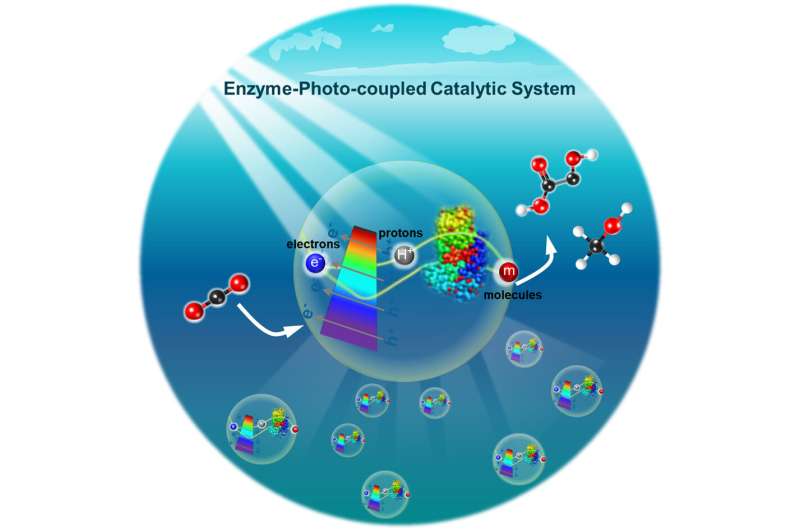This article has been reviewed according to Science X's editorial process and policies. Editors have highlighted the following attributes while ensuring the content's credibility:
fact-checked
trusted source
proofread
Molecule-electron-proton transfer in enzyme-photo-coupled catalytic system

The harmonious coexistence between human society and nature has prompted the rapid development of advanced manufacturing. Typically, green biomanufacturing, which uses renewable resources as raw materials and enzymes or microorganisms as catalysts to produce target chemicals, has been considered to be highly consistent with the 12 principles of green chemistry. Specifically, enzyme-based green biomanufacturing has been extensively applied for many industrial fields such as food, pharmaceutical, chemicals, etc.
Reduction reactions are most commonly employed in enzyme-based biomanufacturing processes. Introducing fossil energy is a frequently used strategy, which not only increases production costs, but also generates oxidation by-products that are difficult to separate. Therefore, using cheap and renewable energy (such solar energy) to achieve sufficient reduction reactions is urgently required to achieve sustainable green biomanufacturing.
Natural photosynthesis offers an ideal prototype for green biomanufacturing, during which green plants absorb sunlight and split H2O into O2, electrons and protons. These electrons and protons are used to drive the synthesis of energy-rich biological reductants, such as NADPH and ATP, which are further involved in the Calvin-Benson cycle to achieve the CO2 fixation.
An enzyme-photo-coupled catalytic system (EPCS) is a typical solar-driven biomanufacturing process. EPCS, as a new model to mimic natural photosynthesis, can use photocatalysts to capture solar energy and further drive the enzyme catalysis for the production of various chemicals. However, the solar-to-chemical conversion efficiency of EPCS is far below theoretical upper limit for the photosynthesis of nature. Conventional EPCS focuses on the development of photocatalysts or the matching of photocatalysts and enzymes, but does not offer guidelines for the construction of EPCS from the perspective of molecule-electron-proton transfer.
Recently, a research team led by Prof. Zhongyi Jiang from Tianjin University, China, proposed a new strategy to strengthen the mass/energy coupling in EPCS by coordinating and optimizing the "new three transfers" (molecule, electron and proton transfer), thus improving the solar-to-chemical conversion efficiency. Natural photosynthesis provides an ideal model with well-matched molecule-electron-proton transfer, which will help shed light on the molecule-electron-proton transfer phenomenon in EPCS.
This review, published in the Chinese Journal of Catalysis, aims to implant the molecule-electron-proton transfer from natural photosynthesis to EPCS. In addition, the current status of and challenges in realizing the synergistic intensification of all three transfers in EPCS were analyzed, and some perspectives on research and development of EPCS were offered by the researchers.
More information: Shihao Li et al, Molecule-electron-proton transfer in enzyme-photo-coupled catalytic system, Chinese Journal of Catalysis (2022). DOI: 10.1016/S1872-2067(22)64154-8
Provided by Chinese Academy of Sciences



















